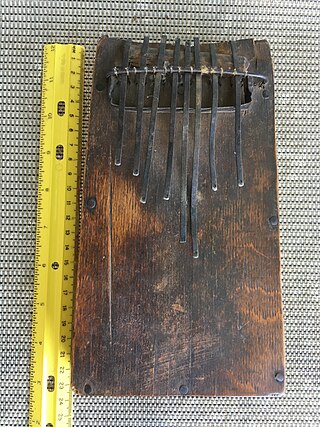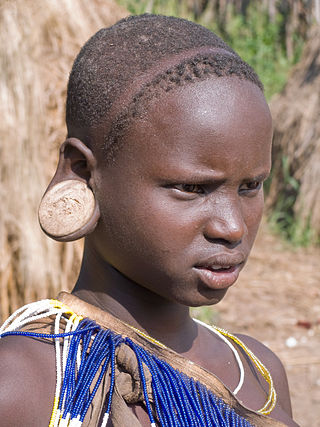Related Research Articles

The Nilo-Saharan languages are a proposed family of around 210 African languages spoken by somewhere around 70 million speakers, mainly in the upper parts of the Chari and Nile rivers, including historic Nubia, north of where the two tributaries of the Nile meet. The languages extend through 17 nations in the northern half of Africa: from Algeria to Benin in the west; from Libya to the Democratic Republic of the Congo in the centre; and from Egypt to Tanzania in the east.
The Agaw or Central Cushitic languages are Afro-Asiatic languages spoken by several groups in Ethiopia and, in one case, Eritrea. They form the main substratum influence on Amharic and other Ethiopian Semitic languages.

The Nilotic languages are a group of related languages spoken across a wide area between South Sudan and Tanzania by the Nilotic peoples.

In most classifications, the Eastern Sudanic languages are a group of nine families of languages that may constitute a branch of the Nilo-Saharan language family. Eastern Sudanic languages are spoken from southern Egypt to northern Tanzania.

The Mursi are a Surmic ethnic group in Ethiopia. They principally reside in the Debub Omo Zone of the Southern Nations, Nationalities, and People's Region, close to the border with South Sudan. According to the 2007 national census, there are 11,500 Mursi, 848 of whom live in urban areas; of the total number, 92.25% live in the Southern Nations, Nationalities, and People's Region (SNNPR).
The Didinga (Didinga) are a Surmic ethnic group that occupy the Didinga Mountains region in Budi County, Eastern Equatoria State in South Sudan. They live in the valleys, on the plateaus and slopes, and on the adjacent plains of the region. Their neighbors include the Toposa, Turkana, Boya, Ketebo, Logir, Ik, Dodos and Dongotona peoples - groups with whom the Didinga have had frequent conflicts due to economic pressures.
The Surmic languages are a branch of the Eastern Sudanic language family.

The Murle are a Surmic ethnic group inhabiting the Pibor County and Boma area in Greater Pibor Administrative Area, South Sudan, as well as parts of southwestern Ethiopia. They have also been referred as Beir by the Dinka and as Jebe by the Luo and Nuer, among others. The Murle speak the Murle language, which is part of the Surmic language family. The language cluster includes some adjoining groups in Sudan, as well as some non-contiguous Surmic populations in southwestern Ethiopia.
Meʼen is a Nilo-Saharan language spoken in Ethiopia by the Meʼen people. In recent years, it has been written with the Geʽez alphabet, but in 2007 a decision was made to use the Latin alphabet. Dialects include Bodi (Podi) and Tishena.

The languages of Ethiopia include the official languages of Ethiopia, its national and regional languages, and a large number of minority languages, as well as foreign languages.
The Tennet people are South Sudanese. Their language is sometimes referred to as Ngaarit. Tennet traditional dances are divided into the following categories: Lalu, Nyaliliya, Loduk, and so on
Mursi is a Southeast Surmic language spoken by the Mursi people who live in the South Omo Zone on the eastern side of the lower Omo valley in southwest Ethiopia. The language is similar to Suri, another Southeast Surmic language spoken to the west of the Mursi language area. It is spoken by approximately 7,400 people.

The Majang people, or Majangir, live in southwestern Ethiopia and speak a Nilo-Saharan language of the Surmic cluster. The 1998 census gave the total of the Majangir population as 15,341, but since they live scattered in the hills in dispersed settlements, their actual total number is undoubtedly much higher. They live around cities of Tepi, Mett'i, and scattered southwest of Mizan Teferi and towards Gambela.

The Majang language is spoken by the Majangir people of Ethiopia. Although it is a member of the Surmic language cluster, it is the most isolated one in the group. A language survey has shown that dialect variation from north to south is minor and does not seriously impede communication. The 2007 Ethiopian Census lists 6,433 speakers for Majang (Messengo), but also reports that the ethnic group consists of 32,822 individuals. According to the census, almost no speakers can be found in Mezhenger Zone of Gambela Region; a total of eleven speakers are listed for the zone, but almost 10,000 ethnic Mejenger or Messengo people.
The Aroid or Ari-Banna languages possibly belong to the Afro-Asiatic family and are spoken in Ethiopia.
Murle is a Surmic Language spoken by the Murle people in the southeast of South Sudan, near the Ethiopian border. A very small number of Murle live across the border in southwestern Ethiopia.
Suri, is a Surmic language spoken in the West Omo Zone of the South West Ethiopia Peoples' Region in Ethiopia, to the South Sudan border by the Suri. The language has over 80% lexical similarity to Mursi. The language is often referred to by another form of its name, Surma, after which the Surmic branch of Eastern Sudanic is named, but that form is frequently used for the three related languages spoken by the Surma people: Suri, Mursi, and Me'en.

Suri is a collective name for three ethnic groups mainly living in Suri woreda, in southwestern Ethiopia. They share many similarities politically, territorially, culturally and economically but speak different languages. They all speak South East Surmic languages within the Nilo-Saharan language family, which includes the Mun, Majang, and Me'en people's languages.
Tennet is a Surmic language spoken by the Tennet people in South Sudan. The Tennet home area is a group of fifteen (15) villages at the northern part of Eastern Equatoria state, 65 kilometers northeast of Torit.
Gumuz is a dialect cluster spoken along the border of Ethiopia and Sudan. It has been tentatively classified within the Nilo-Saharan family. Most Ethiopian speakers live in Kamashi Zone and Metekel Zone of the Benishangul-Gumuz Region, although a group of 1,000 reportedly live outside the town of Welkite. The Sudanese speakers live in the area east of Er Roseires, around Famaka and Fazoglo on the Blue Nile, extending north along the border. Dimmendaal et al. (2019) suspect that the poorly attested varieties spoken along the river constitute a distinct language, Kadallu.
References
- 1 2 3 4 5 6 7 8 9 Baale at Ethnologue (18th ed., 2015) (subscription required)
- 1 2 3 4 5 6 7 8 9 Dimmendaal, Gerrit. 2002. "Sociolinguistic Survey Report on Tirma, Chai, Baale, and Mursi" SIL Electronic Survey Reports 2002-033.
- ↑ Unseth, Peter. 1988. The Validity and Unity of the Southeast Surma Language Grouping. Northeast African Studies 10.2/3:151-163.
- ↑ Unseth, Peter. 1997. Disentangling the Two Languages Called “Suri”. Occasional Papers in the Study of Sudanese Languages 7:49-69.
- 1 2 3 Möller, Mirjam. 2009. Vowel Harmony in Bale - A Study of ATR Harmony in a Surmic Language of Ethiopia. BA thesis. University of Stockholm. Online access
- ↑ Yigezu, Moges. 2005. “Convergence of Baale: A Southwest Surmic Language to the Southeast Surmic group, lexical evidence.” APAL (Annual Publication in African Linguistics) 3: 49-66.
- ↑ Chan, Eugene S. L. 2013. "Baalesi" Archived 2014-05-05 at the Wayback Machine at Numeral Systems of the World's Languages Archived 2014-04-21 at the Wayback Machine . Leipzig, Germany: The Department of Linguistics, Max Planck Institute.
- ↑ Video depicting Surma women wearing lip plates
- ↑ Video depicting the Donga stick fighting festival